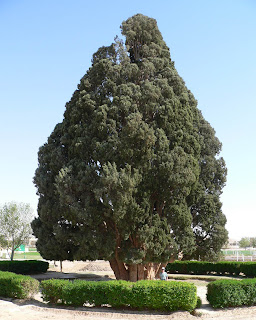Meet the organisms that have outlived the Egyptian pyramids, the Roman Empire and all humanity.
As humans we are familiar with lifespans on a decadal timescale. Human life expectancies vary globally from 32 to 83 years and the oldest person ever officially recorded was a whopping 122 years old. It is amazing to think animals such as the giant tortoise can live past the age of one hundred, such as the legendary Lonesome George. Nevertheless, these lifespans are truly eclipsed by representatives from the plant kingdom.
 |
| Methuselah |
The oldest individual living organism on Earth is a bristlecone pine, aptly named Methuselah, from the Hebrew Bible. This individual, hidden away in the ‘Forest of Ancients’ in the Inyo National Forest of California, is an incredible 4,800 years old. To put that into perspective, the tree must have sprouted around 2800 BC! It was already a centenarian before the first Egyptian pyramids and the Mayan civilization would not appear for 800 years. It has existed through wars and the rise and falls of civilisations, yet it still sits there humbly in the mountains of California. Bristlecone Pines are not particularly large, reaching around 50 feet, and they grow very slowly, taking around 700 years to grow 3 feet! At first glance the plant appears rather drab, but so would you if you had outlasted every other single organism on the planet.
Believe it or not, Methuselah is not the oldest recorded individual tree, there is a member of the same species that was older. This was Prometheus, which might have been 5,000 years old. Unfortunately Prometheus was felled by an enthusiastic graduate student in 1964! There is a chance that Methuselah may over take its rival and continue to live past our great-great grandchildren. Who knows, scientists might be blogging about a 6,000 years old tree in the very distant future.
 |
| Sarv-e-Abarkooh |
So why do some trees live so long? Their compartmentalised vascular system helps considerably, allowing sections of the tree to deteriorate while the individual survives. They also have the ability to synthesise defensive compounds to protect against parasites and bacteria. An underlying physiological mechanism prevents genetic mutations from accumulating in their cells to the same extent as other organisms. Longevity is naturally selected as it increases the organism’s reproductive opportunities.
We have trees that have existed for thousands of years, how would you feel if I told you there are plants that may have lived for tens and hundreds of thousands of years, surely not? The exceptional trees described above are all individual units, with a single stem and root system. There are a group of plants which have evolved a clonal mode of life. This involves using many genetically identical clones stems that to the untrained eye, appear to be individual trees, but beneath the surface they are all connected in a massive network of roots. This allows these plants to defy time. The loss of a single unit stem or ‘tree’ does not mean the death of the overall organism and clonal colonies can live for incredibly long periods.
.JPG) |
| Part of the 'Pando' colony |
 |
| Old Tjikko |
In February 2012 a new contender to the title of oldest colonial organism was announced. To find it we have to venture into the marine realm. Reports suggested a species of seagrass, Posidonia oceanica, along the Mediterranean coast is between 80,000 and 200,000 years old. It looks like a meadow but as with other clonal colonies, it is all one genetic individual. Ironically, this ancient seagrass now faces its greatest threat - humanity. Induced Mediterranean climate change is causing P. oceanica meadows to decline by around 5% each year. You will also remember that it was a freak human related accident that led to the felling of Prometheus and ‘The Senator’, previously the fifth oldest living tree, was burnt down by a woman in Florida in 2012! As a species we must be careful we do not destroy these wonderful relics.

